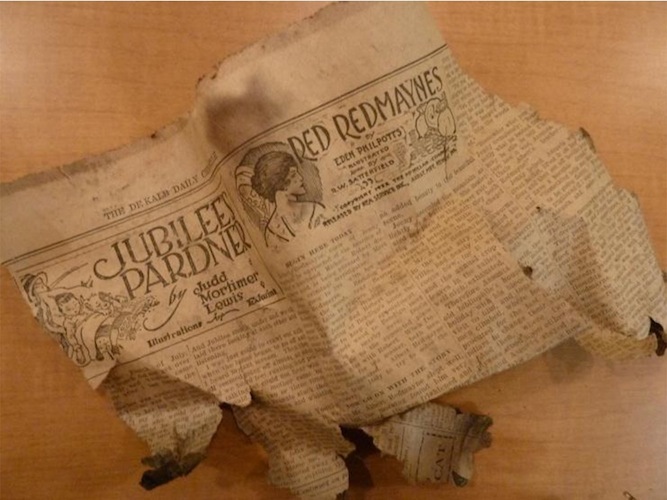An Unexpected Discovery Highlights a Recent Kane County Nature Hike
January 30, 2013
You never know what you’ll find on a hike. Pam Otto discovered this crumpled 90-year-old partial page from the DeKalb Daily Chronicle recently on Illinois Route 38 near Pouley Road in western Kane County. Photo by author.
– Contributed by Pam Otto
One of my very favorite things about taking a walk outside is that you never know what you might find. Even when you set out with a single purpose in mind, your trek may yield discoveries you never dreamed possible.
Take the walk I went on a few weeks ago with my coworker Lisa O’Brien. Heading to western Kane County, Lisa (the same person who spotted the tagged red-tailed hawk we wrote about a few weeks ago) had noticed an odd series of burrows along the north side of Route 38 near Pouley Road. A frequent traveler out that way, she said it appeared that the burrows were increasing in number. We both wondered whether this activity indicated that a badger was in the vicinity and, given the sunny and 50F weather that day, decided to go check it out.
Now, I’ll tell you upfront that we never did conclusively decide whose work those burrows may be. They seem fairly deep, and at 10+ inches across certainly wide enough to accommodate a badger. But what was missing were the telltale claw marks badgers typically leave on the burrows’ interior walls, as well as strands of fur around the entrances–another sure-fire badger sign.
We did pick up another interesting clue, a lump of what naturalists refer to as scat, that had been left near one of the burrows. The lump’s contents— namely fur and bones—might possibly indicate its originator was a badger. But it wasn’t very big, and its condition was somewhat degraded; it could just as easily have been a pellet ejected by a raptor as scat deposited by a badger, or even another sort of carnivore. But I digress.
Lisa said she will continue to watch for more burrows appearing along that hilly rise or on other embankments in that area; she will also pay close attention this spring to see if any woodchucks— another mammal that digs extensively—appear in that area after their long winter’s nap.
Remember how I said you can make interesting and unforeseen discoveries when you’re out for a walk? That’s exactly what happened next.
As Lisa headed in one direction toward her vehicle, I headed in the other toward mine. Granted, we were pulled off the road along the north side of 38, so the conditions were far from natural—gravel shoulder, assorted flotsam from passing cars, a scrap of newspaper…
Yet it was that paper that caught my eye. It was weathered—then again, what wouldn’t be, given the exposed nature of roadsides. But this paper looked, well, different.
The fonts were unlike any I was familiar with in current newspapers, and the illustrations too looked very old fashioned.
Intrigued by its oddities, undaunted by the curious stains along the edge (and thinking, what the heck, I already had tucked a scat sample in my coat pocket), I reached down and seized the scrap, just as a gust of wind was about to blow it away.
The print across the top of the page read The De Kalb Daily Chronicle. Below that were two columns that appeared to be excerpts from books—Jubilee’s Pardner by Judd Mortimer Lewis and Red Redmaynes by Eden Philpotts—highlighted by fancy script and vintage drawings.
On the other side of the page were the sorts of text and photos you’d expect to see in a newspaper, although the headline that was still legible, “Only Woman Gold Mine Manager,” did stand out as a bit unusual.
Then I saw it. The year the newspaper was published.
1923.
What the…?
I’ve done a lot of traipsing about our beautiful county, and I’ve found some mighty strange and wondrous things. But 90-year-old newspaper?
I’m not a historian, so my hypotheses of what happened are somewhat limited. But I’m wondering if perhaps somewhere in that vicinity of Rte. 38 and Pouley there might be an old building that either had newspapers piled inside, or perhaps had at one time been insulated with newspapers of the day. Then, with the passage of time and exposure to the elements, this scrap tore free.
Or, given the dark, almost burn-like, splotch on one end, perhaps this bit of history blew away from a nearby burn pile.
At any rate, I know that this coming spring, when Lisa and I head back to 38 and Pouley to scout out more evidence of badgers or woodchucks or what have you, I’ll also be keeping my eyes peeled for more wayside trash. There may be a lot more where this came from. Up to 90 years worth…
Pam Otto is manager of Nature Programs and Interpretive Services with the St. Charles Park District.







